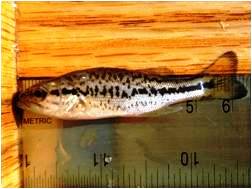 In this world of instant everything - text and instant messaging, the Internet, GPS coordinates for bassin’ hot spots – we tend to think that there are fast and simple answers to solve every problem. For example, you have a poor quality bass lake, or fishing has become a little slow these past couple years on the home waters,  simply stock a bunch of largemouth and everything will be better.
In this world of instant everything - text and instant messaging, the Internet, GPS coordinates for bassin’ hot spots – we tend to think that there are fast and simple answers to solve every problem. For example, you have a poor quality bass lake, or fishing has become a little slow these past couple years on the home waters,  simply stock a bunch of largemouth and everything will be better.
But, as has frequently been reported in the literature, stocking of largemouth bass tends to not be too productive in changing or altering a fishery over the long term. Many states don’t even make it a policy to stock largemouth bass in anything but new or completely renovated lakes.
Why is this? A couple new studies** give us some interesting insights.
For one, stocked fish have poor survival and no better growth rates than naturally occurring bass. Apparently, differing lengths don’t change anything dramatically to that degree.
The smallest size juveniles stocked had the worst survival rate. Beyond that though, further increases in size stocked didn’t create any differences in survival among the remaining groups.
Mortality from predation ranged as high as 25%, and interestingly 99% of all predation on stocked bass was by other (adult) largemouth bass. The one caveat to this was that the largest size fingerlings stocked (~8″) were not consumed by other adults. Still, this didn’t translate into any long term population benefits.
Another issue is that a lot of the predator fish that are raised and ultimately stocked in our lakes are reared on pellets. As such, there is what is termed a “domestication effect” whereby the little predators don’t really learn how to hunt and feed well on their own, and also don’t learn to be afraid of big and nasty creatures roaming the waters with them. Hence, stocking studies in Florida have shown a survival rate of as little as 3% in some cases.
A neat study that radio tagged both hatchery reared and wild largemouth bass juveniles found some interesting behavioral discrepancies.
- In the first 30 days post stocking, hatchery bass suffered 62% mortality compared to 18% experienced by the wild bass.
- Of the 30 hatchery tagged bass, 47% were determined to have been eaten by other fish, and 3 others by birds.
- On average, hatchery-reared bass moved about 3 times more in a given day compared to wild bass.
In simple terms, pellet reared bass are a little less bright, or more likely ‘naive’ (not trying to be anthropomorphic here). They run around more, not realizing the danger they put themselves in, and it seems they’ve never met a stranger, even one who decided to eat them for lunch. Kind of reminds you of hatchery trout out in Cali.
The basic message from these studies, similar to what many others have found, is that you can rarely stock your way to a successful largemouth fishery much beyond what natural population is already supported by the water body.
** Diana, M.J., D.H. WAHL. Growth and Survival of Four Sizes of Stocked Largemouth Bass. North American Journal of Fisheries Management 29:1653–1663, 2009.
**Thompson, B., Porak, W. The Use of Radiotelemetry to Evaluate Survival, Behaviour, and Habitat Selection of Stocked Hatchery Largemouth Bass. AFS Conference Presentation, 2011.

























Chad Keogh
August 22, 2011 at 8:00 am
I’m sure from a scientific perspective the fishery managers should be asking themselves why the bass aren’t naturally thriving first, before jamming more in there. Maybe it’s the habitat, maybe it’s a lack of prey, maybe the lake it really still full of bass but they’ve learned the local anglers tricks due to years of catch and release and the anglers haven’t adapted by learning new tricks…
BryanT
August 22, 2011 at 9:22 am
Yup, after my little run in college where my focus was fisheries. Stocking does nothing without good spawning habitat, great nurseries to have have great recruitment, and of course the predator/prey balance has to be there. If you have those three things the only reason to ever stock is for angler satisfaction. It is documented in studies that lakes have “smart” fish that maybe aren’t fooled by lures as much as the anglers would like. I like going where the dumb fish are, like Falcon.
Chance
August 23, 2011 at 6:29 am
WOW……. is this too much stocking?
http://www.tpwd.state.tx.us/publications/pwdpubs/media/pwd_br_t3200_1449_tagged.pdf
Chance
August 23, 2011 at 6:31 am
I meant this link on Lake Fork stacking, a lot of fish!
http://www.tpwd.state.tx.us/fishboat/fish/action/stock_bywater.php?WB_code=0433
Brian
August 23, 2011 at 10:09 am
LOL, nope. That’s the way to offset the problems mentioned above, where you basically create an artificial fishery by stocking lots and stocking often – overwhelm the system. Studies suggest though that if they ever stopped stocking at that level, the fishery would fall back into it’s more normal ‘balanced’ capacity in a relatively short amount of time.